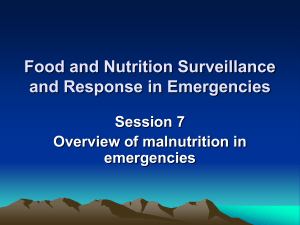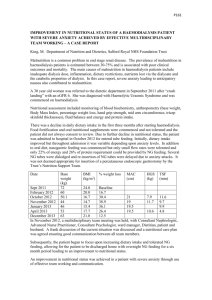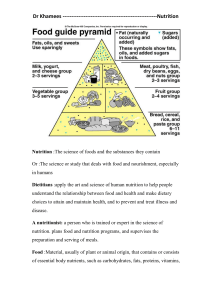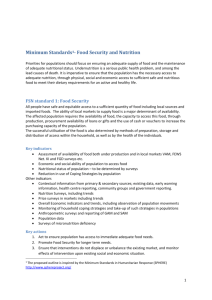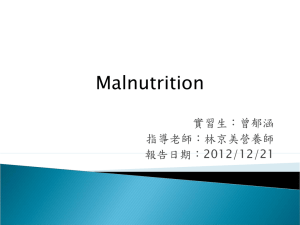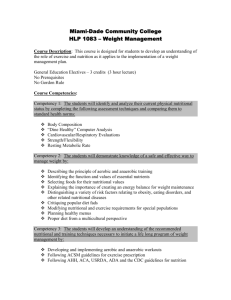- National Food Policy Capacity Strengthening
advertisement
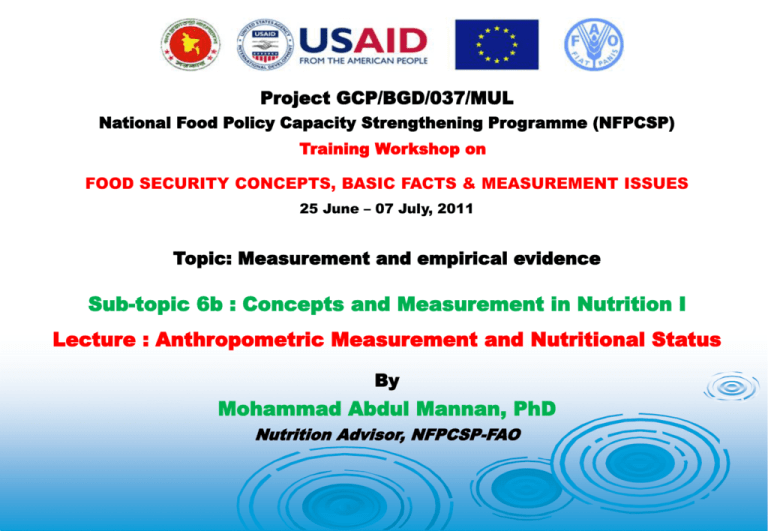
Project GCP/BGD/037/MUL National Food Policy Capacity Strengthening Programme (NFPCSP) Training Workshop on FOOD SECURITY CONCEPTS, BASIC FACTS & MEASUREMENT ISSUES 25 June – 07 July, 2011 Topic: Measurement and empirical evidence Sub-topic 6b : Concepts and Measurement in Nutrition I Lecture : Anthropometric Measurement and Nutritional Status By Mohammad Abdul Mannan, PhD Nutrition Advisor, NFPCSP-FAO OUTLINE OF PRESENTATION Introduction Nutrition Indicators Nutritional Assessment Anthropometric Measurement Stunting, Wasting, Underweight and Classification BMI & MUAC and Classification Biochemical Assessment of Micronutrient Malnutrition Health Indicators Summary INTRODUCTION The nutritional status of an individual is often the result of many inter-related factors. It is influenced by food intake, quantity & quality, & physical health. The spectrum of nutritional status spreads from severe malnutrition to obesity National sources of anthropometric data and nutrition status information Bangladesh Demographic and Health Surveys (BDHS) : every 3 years Multiple Indicators Cluster Surveys (MICS) : 5 years Food Security and Nutrition Surveillance : (3 rounds/year) Other surveys : need/issue specific (IYCF, VAD) Nutritional Assessment - Why? The purpose of nutritional assessment is to: Identify individuals or population groups at risk of becoming malnourished Identify individuals or population groups who are malnourished Nutritional Assessment –Why? To develop nutrition and health care programs that meet the community needs which are defined by the assessment To measure the effectiveness of the nutritional programs & intervention once initiated Indicators to assess and analyse nutrition In the Triple-A Cycle model: ASSESSMENT of the nutritional situation in target population ACTION based on the analysis & available resources ANALYSIS of the causes of the problem The ASSESSMENT stage aims to define the nutritional problem in terms of magnitude and distribution. The ANALYSIS stage aims to analyse the causes of malnutrition Nutrition and health indicators Different indicators are used for assessment and analysis purposes. Indicators used to define the nutritional problem Indicators used to analyze the causes of the problem They address the following questions: • Who suffers from malnutrition? • What is the type of malnutrition? • When? • Where? They address the following question: • Why are people malnourished or at risk of malnutrition? ANTHROPOMETRIC AND MICRONUTRIENT DEFICIENCY INDICATORS FOOD, HEALTH AND CARE PRACTICE INDICATORS 1. Intra-uterine Undernutrition: Low Birth Weight (LBW) Malnutrition can begin from intra-uterine life, mainly due to maternal malnutrition. Maternal malnutrition during pregnancy retards the growth and development of the foetus. The foetus, therefore, is born with birth weight lower than normal. When the birth weight of a full-term foetus is below a cut-off level, the newborn is termed as a LBW baby. According to WHO, the cut-off value for birth weight is 2.5 kg. Therefore, babies born with birth weight <2.5 kg are LBW babies. In Bangladesh, the prevalence of LBW was found 43% [BDHS 2004]. LBW babies make a bad start in life. Their chance of survival is poor; they have less ability to resist diseases, therefore, suffer from frequent infection, and soon become severely malnourished. Many do not live up to their first birthday. 2. Childhood Malnutrition The consequences of malnutrition are most severe if it happens very early in life. Malnutrition from this time in life onward has long lasting effects on subsequent growth, morbidity, cognitive development, educational attainment and productivity in adulthood. For these reasons, nutrition status of young children, particularly those aged below 5 years, has been shown to be one of the most sensitive indicators of food security, vulnerability and overall socioeconomic development of a country. Nutritional assessment - ABCD Anthropometry: height, weight, BMI, MUAC Biochemical: analysis of blood, urine, and other body tissues Clinical: complete physical examination, and a medical and psychosocial history Dietary: foods and quantities eaten, eating habits, accessibility of food, and cultural and socioeconomic factors that affect selection of food. Measuring Nutritional Status Infant and Young Child Feeding Practice Measurement of growth and body composition (anthropometric indicators) Biochemical content of blood and urine (biochemical indicators) Clinical examination of external physical signs of nutrient deficiencies (clinical indicators) Nutritional indicators Nutritional indicators are the quantitative threshold or cut-off values by which the nutritional status of the population can be assessed. Since malnutrition is seen among the population throughout the life cycle, different indicators have been developed to assess nutritional status of population of different age and gender groups. Potential key indicators to be mapped at national & subnational levels by sector FOOD AND NUTRITION Nutritional status indicators Underweight (children under five) Stunting (children under five) Wasting (children under five) Body-Mass-Index (<18.5 adults) Low birth weight (LBW) Vitamin A deficiency-night blindness (Children under five) Total goitre rate (TGR) Percentage of households consuming iodized salt ADVANTAGES OF NUTRITIONAL ANTHROPOMETRY Methods are precise and accurate, provided standardized techniques are used Procedures use simple, safe and non-invasive techniques Equipment required is inexpensive, portable and durable, and can be made or purchased locally Relatively unskilled personnel can perform measurement procedures Information is generated on past nutritional history Methods can be used to quantify the degree of under-nutrition (or overnutrition) and provide a continuum of assessment Methods are suitable for large sample sizes such as representative population samples Methods can be used to monitor and evaluate changes in nutritional status over time, seasons, generations, etc. Methods can be adapted to develop screening tests to identify those at high risk. Source: Gibson (1990). LIMITATIONS OF NUTRITIONAL ANTRHOPOMETRY The relative insensitivity to detect changes in nutritional status following inadequacy of food over short periods of time The inability to distinguish the effect of specific nutrient deficiencies (e.g. zinc deficiency) that affect growth in children from that due to inadequacy of food in general The inability to pinpoint the principal causality of undernutrition, as the poor nutritional status may be the result of factors such as repeated insults owing to infections and poor care in children The relative higher costs and organization required to obtain representative and quality data for the purpose of estimating numbers of undernourished Nutritional status can be assessed through: Anthropometric measurements: Several anthropometric indicators have been identified for assessment of nutrition status of U-5 children. These are Stunting - refers to low height-for-age, Wasting - low weightfor-height and Underweight - low weight-for-age. The Z-score classification of these indicators is most widely used. A. Stunting (low height-for-age) Under-nutrition for a long time retards the growth of a child by height. The child is shorter than for its age. This is called “Stunting”. For this, both height and age are to be known. It reflects a process of failure to reach linear growth potential due to sub-optimal food and/or health conditions in early childhood (<2 year). The condition needs remedy in early childhood, otherwise the process is irreversible. The child is said to be of normal height, if its height-for-age is within 2 standard deviations (-2SD) of the median height-for-age of a reference population. If the height falls below 2SD (<-2SD) but within 3 SD below the reference median (-3SD), then the child is classified to moderately stunted. If the height falls below 3 SD of the reference median (<-3SD), then the child is classified as severely stunted. The classification can be summarized as follows: Stunting: Height-for-age up to –2SD = Normal Height-for-age <-2SD to –3SD = Moderate Height-for-age <-3SD = Severe B. Wasting (low weight–for-height) Wasting is a measure of underweight relative to height and indicates a weight deficit associated with acute starvation and/or severe disease. Acute, short-term malnutrition does not affect the height, but the body weight. This is seen as “Wasting” of the body, i.e. loss of body mass compared to the body size. Weight-for-height is therefore a useful indicator for assessing body wasting. For this, age does not need to be known. The child is said to be of normal weight-for-height, if its weight-for-height is within 2 standard deviations (-2SD) of the median weight-for-height of a reference population. If the weight-for-height falls below 2SD (<-2SD) but within 3 SD below the reference median (-3SD), then the child is classified as moderately wasted. If the weight-for-height falls below 3SD of the reference median (<-3SD), then the child is classified as severely wasted. The classification can be summarized as follows: Wasting: Weight-for-height up to –2SD = Normal Weight-for-height <-2SD to –3SD = Moderate Weight-for-height <-3SD = Severe C. Underweight (low weight-for-age) This is a composite indicator of long-term and acute shortterm malnutrition. The body weight may be lost from malnutrition for a long time. The child is then low weightfor-age. Weight may also be lost from acute, short-term malnutrition. In this case also, the child is low weight-forage. For this, both weight and age are to be known. The child is said to be of normal, if its weight-for-age is within 2 standard deviations (-2SD) of the median weightfor-age of a reference population. If the weight-for-age falls below 2SD (<-2SD) but within 3 SD below the reference median (-3SD), then the child is classified as moderately underweight. If the weight-for-age falls below 3SD of the reference median (<-3SD), then the child is classified as severely underweight. The classification can be summarized as follows: Underweight : Weight-for-age up to –2SD = Normal Weight-for-age <-2SD to –3SD = Moderate Weight-for-age <-3SD = Severe GROWTH MONITORING AND PROMOTION - GMP Growth monitoring is the continuous monitoring of growth in children. It can be performed at the individual level, or at a group level. It can also be: Clinic-based growth monitoring (conducted by health professionals at Maternal and Child Health clinics), OR Community-based growth monitoring (conducted by trained members of the community in villages ) Mothers Waiting for Growth Monitoring and Promotion D. Mid-upper-arm Circumference (MUAC) Between the ages of 1 and 5 years, there is very little change in a normal child’s arm circumference. Thus, this measurement gives a simple anthropometric measure of wasting which is almost age-independent. The degree of severity of malnutrition in children on the basis of MUAC is given below. MUAC >14 12.5 – 14.0 cm = Normal cm = Mild/moderate wasting <12.5 cm = Severe wasting 3. Maternal malnutrition The most common nutritional problem in women, especially the poor, is chronic energy deficiency (CED). CED is measured by height as well as by Body Mass Index (BMI). A. Height <145cm is indicative of chronic CED. BMI is derived by dividing weight (in kg) by height squared (in meters). Weight (kg) BMI = ---------------------Height2 (meter) = (kg/m2) B. BMI is widely used to assess nutritional status of children above 10 years of age and the adults as follows: BMI >30 = Obese 25.1 – 30.0 = Overweight 18.5 - 25.0 = Normal <18.5 = Malnourished <16.5 = Severely malnourished C. Mid-upper arm circumference (MUAC) MUAC is a better indicator of mortality risk associated with malnutrition than Weight-for-Height. It is therefore a better measure to identify children most in need of treatment. MUAC is simple, cheap, more sensitive and less prone to mistakes. Appropriate cut-off points of MUAC for children between 6 to 59 months are given below: >13.5 cm Normal 12.5 to13.5 cm At risk of acute malnutrition 11.0 to 12.5 cm Moderate acute malnutrition <11.0 cm Severe acute malnutrition Children Mid-upper arm circumference (MUAC) for Adults As with children, MUAC can be used to grade the degree of body wasting in adults. Appropriate cut-off points of MUAC for adults are given below: Male ≥23 cm <23 cm Normal Malnourished Female ≥22 cm <22 cm Normal Malnourished Nutrition indicators for monitoring and impact assessment Intervention Most relevant nutritional indicators Improved availability of food (dietary energy) at the household level, in areas where dietary energy intake is initially constrained BMI (adults) Weight-for-height Z-score (2-5 year olds) Weight-for-age Z-score (2-5 year olds) Height-for-age Z-score (long-term evaluations only; 2-5year olds) Improved availability of food at the individual level, plus improvements in other basic needs, especially health Height-for-age Z-score (under 5s) Weight-for-age Z-score (under 5s) Weight-for-height Z-score (under 5s) Increased intake of animal products Anemia (Hemoglobin) Serum Vitamin A (retinol) Increased intake of fruits and leaves Serum Vitamin A (retinol) 4. Micronutrient malnutrition The most widely prevalent micronutrient malnutrition problems are: Vitamin A deficiency, Iodine deficiency, and Iron deficiency. A. Vitamin A deficiency Chronic dietary vitamin A deficiency first leads to night blindness and then, in untreated cases, to total blindness. Sub-clinical vitamin A deficiency is present in a much larger population than clinical blindness. Serum retinol (vitamin A) level is a dependable indicator for sub-clinical vitamin A deficiency. The cut-off value for serum retinol is given below: Serum retinol ≥ 20 µg/100 ml = Normal Serum retinol <20 µg/100 ml = Vitamin A deficiency Serum retinol <10 µg/100 ml = Severe vitamin A deficiency B. Iodine deficiency Chronic dietary iodine deficiency first leads to enlargement of the thyroid gland such that it is not yet visible. This goiter is called Grade 1 goitre. In untreated cases, Grade 1 goiter develops into Grade 2 goitre, which now becomes visible. As with vitamin A deficiency, sub-clinical (also called biochemical) iodine deficiency is present in a larger population than goiter. Urinary iodine level is an internationally accepted and widely used indicator of iodine deficiency. The cut-off value for urinary iodine is given below: Urinary iodine excretion (UIE) <20 micrograms/litre = Severe iodine deficiency Urinary iodine excretion (UIE) <100 micrograms/litre = Iodine deficiency Urinary iodine excretion (UIE) ≥100 micrograms/litre = Normal C. Iron deficiency and iron deficiency anaemia Chronic dietary iron deficiency first leads to depletion of iron stores of the body (in the form of ferritin in liver). This is called iron deficiency. Serum ferritin <12 mg/100ml = Iron deficiency When the iron store falls below such level that it cannot support haemoglobin synthesis, haemoglobin level begins to fall. If haemoglobin falls below a critical level, then it is anaemia. The severity of anaemia depends on how low is haemoglobin level. This can be measured by determining haemoglobin concentration in whole blood. The biochemical indicators of iron deficiency and anaemia are as follows: The critical levels of haemoglobin (g/L) vary according to different age and sex groups and also various physiological conditions. Group Children (6 - 59 Mo) Children (5 - 11 Yr) Children (12 - 14 Yr) Male 15+ Yr Female 15+ Yr Pregnant women Lactating mothers Normal Mild anaemia Moderate anaemia Severe anaemia ≥110 100 – 109 70 - 99 <70 ≥115 100 - 114 70 - 99 <70 ≥120 100 - 119 70 - 99 <70 ≥130 100 - 129 70 - 99 <70 ≥120 100 - 119 70 - 99 <70 ≥110 100 - 109 70 - 99 <70 ≥120 100 - 119 70 - 99 <70 Basic health indicators Immunization rate for measles, tuberculosis, diphtheria, poliomyelitis and tetanus (one-year-olds) Prevalence of infectious diseases and epidemics (malaria, cholera, AIDS and other) Access to safe water (rural and urban) Rural access to safe water Urban access to safe water Basic health indicators ……. Access to adequate sanitation Infant mortality rate Under five mortality rate Maternal mortality rate Percentage of all cases of diarrhea in children under five yr of age treated with ORS and/or recommended home fluids Infants 0-6 months exclusively breastfed Infants 6-9 months breastfed with minimum acceptable diet Infants at 20-23 months with minimum acceptable diet and continued breast feeding Summary Nutritional status assessments enable to determine whether a population group is wellnourished or undernourished by using anthropometric measurements, biochemical testing or by identifying physiological signs. The main data collection methodologies that provide anthropometric information are: population-based surveys, growth monitoring, and sentinel site and school census data. Additional information on factors such as food security, livelihoods, and health and care practices is usually necessary to interpret nutritional status data and determine the likely causes of malnutrition. Information on nutritional status, combined with the analysis of underlying causes, will provide the understanding needed to select the appropriate intervention. Combination of dietary, anthropometric and biochemical indicators can strengthen nutrition assessment and its quality. Experience shows that multi-sectoral interventions have a better chance of improving the nutritional status of the population. If you want to know more... Online resources •Nutrition Assessment: Background Papers. World Bank/UNICEF. http://www.tulane.edu/~internut/Trial/RSRC.htm •Sphere handbook. http://www.sphereproject.org/handbook/ •Practical anthropometry 101 and 102, International Food Policy and Research Institute. http://www.ifad.org/gender/tools/hfs/anthropometry/ant_toc.htm •Anthropometric indicators measurement guide, 2003. http://www.fantaproject.org/publications/anthropom.shtml •Field Exchange on Emergency Nutrition Network digital archives 2005. www.ennonline.net •Improving the analysis of food insecurity. Food Insecurity Measurement, Livelihoods Approaches and Policy: Applications in FIVIMS. S. Devereux et al. 2004. http://www.fivims.net/documents/Final%20Paper5.pdf •State of Food Insecurity (SOFI) 2001. Food and Agriculture Organization. http://www.fao.org/DOCREP/003/Y1500E/y1500e04.htm •"Nutrition indicators for development - Reference Guide." B. Maire and F. Delpeuch. Institut de Recherche pour le Développement (IRD), Montpellier, France. FAO, 2005. http://www.fao.org/docrep/008/y5773e/y5773e00.htm •"Guidelines for Participatory Nutrition Projects" FAO Reprinted, 1994,1995, http://www.fao.org/documents/show_cdr.asp?url_file=/docrep/V1490E/V1490E00.htm •"Participatory Appraisal of Nutrition and Household Food Security Situations and Planning of Interventions from a Livelihoods Perspective - Methodological Guide." Karel Callens and Bernd Seiffert. FAO 2003. http://www.fao.org/documents/show_cdr.asp?url_file=/docrep/006/ad694e/ad694e04.htm Thank You for Your Kind Attention !

